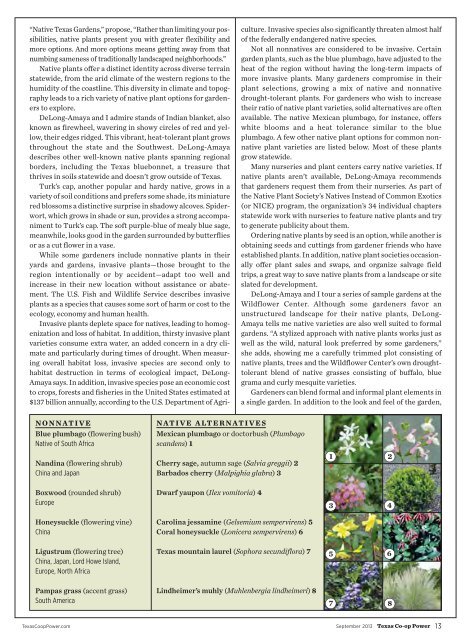AROUND
September 2013PDF 10.25 MB - South Plains Electric Cooperative
September 2013PDF 10.25 MB - South Plains Electric Cooperative
You also want an ePaper? Increase the reach of your titles
YUMPU automatically turns print PDFs into web optimized ePapers that Google loves.
“Native Texas Gardens,” propose, “Rather than limiting your possibilities,<br />
native plants present you with greater flexibility and<br />
more options. And more options means getting away from that<br />
numbing sameness of traditionally landscaped neighborhoods.”<br />
Native plants offer a distinct identity across diverse terrain<br />
statewide, from the arid climate of the western regions to the<br />
humidity of the coastline. This diversity in climate and topography<br />
leads to a rich variety of native plant options for gardeners<br />
to explore.<br />
DeLong-Amaya and I admire stands of Indian blanket, also<br />
known as firewheel, wavering in showy circles of red and yellow,<br />
their edges ridged. This vibrant, heat-tolerant plant grows<br />
throughout the state and the Southwest. DeLong-Amaya<br />
describes other well-known native plants spanning regional<br />
borders, including the Texas bluebonnet, a treasure that<br />
thrives in soils statewide and doesn’t grow outside of Texas.<br />
Turk’s cap, another popular and hardy native, grows in a<br />
variety of soil conditions and prefers some shade, its miniature<br />
red blossoms a distinctive surprise in shadowy alcoves. Spiderwort,<br />
which grows in shade or sun, provides a strong accompaniment<br />
to Turk’s cap. The soft purple-blue of mealy blue sage,<br />
meanwhile, looks good in the garden surrounded by butterflies<br />
or as a cut flower in a vase.<br />
While some gardeners include nonnative plants in their<br />
yards and gardens, invasive plants—those brought to the<br />
region intentionally or by accident—adapt too well and<br />
increase in their new location without assistance or abatement.<br />
The U.S. Fish and Wildlife Service describes invasive<br />
plants as a species that causes some sort of harm or cost to the<br />
ecology, economy and human health.<br />
Invasive plants deplete space for natives, leading to homogenization<br />
and loss of habitat. In addition, thirsty invasive plant<br />
varieties consume extra water, an added concern in a dry climate<br />
and particularly during times of drought. When measuring<br />
overall habitat loss, invasive species are second only to<br />
habitat destruction in terms of ecological impact, DeLong-<br />
Amaya says. In addition, invasive species pose an economic cost<br />
to crops, forests and fisheries in the United States estimated at<br />
$137 billion annually, according to the U.S. Department of Agriculture.<br />
Invasive species also significantly threaten almost half<br />
of the federally endangered native species.<br />
Not all nonnatives are considered to be invasive. Certain<br />
garden plants, such as the blue plumbago, have adjusted to the<br />
heat of the region without having the long-term impacts of<br />
more invasive plants. Many gardeners compromise in their<br />
plant selections, growing a mix of native and nonnative<br />
drought-tolerant plants. For gardeners who wish to increase<br />
their ratio of native plant varieties, solid alternatives are often<br />
available. The native Mexican plumbago, for instance, offers<br />
white blooms and a heat tolerance similar to the blue<br />
plumbago. A few other native plant options for common nonnative<br />
plant varieties are listed below. Most of these plants<br />
grow statewide.<br />
Many nurseries and plant centers carry native varieties. If<br />
native plants aren’t available, DeLong-Amaya recommends<br />
that gardeners request them from their nurseries. As part of<br />
the Native Plant Society’s Natives Instead of Common Exotics<br />
(or NICE) program, the organization’s 34 individual chapters<br />
statewide work with nurseries to feature native plants and try<br />
to generate publicity about them.<br />
Ordering native plants by seed is an option, while another is<br />
obtaining seeds and cuttings from gardener friends who have<br />
established plants. In addition, native plant societies occasionally<br />
offer plant sales and swaps, and organize salvage field<br />
trips, a great way to save native plants from a landscape or site<br />
slated for development.<br />
DeLong-Amaya and I tour a series of sample gardens at the<br />
Wildflower Center. Although some gardeners favor an<br />
unstructured landscape for their native plants, DeLong-<br />
Amaya tells me native varieties are also well suited to formal<br />
gardens. “A stylized approach with native plants works just as<br />
well as the wild, natural look preferred by some gardeners,”<br />
she adds, showing me a carefully trimmed plot consisting of<br />
native plants, trees and the Wildflower Center’s own droughttolerant<br />
blend of native grasses consisting of buffalo, blue<br />
grama and curly mesquite varieties.<br />
Gardeners can blend formal and informal plant elements in<br />
a single garden. In addition to the look and feel of the garden,<br />
NONNATIVE<br />
Blue plumbago (flowering bush)<br />
Native of South Africa<br />
NATIVE ALTERNATIVES<br />
Mexican plumbago or doctorbush (Plumbago<br />
scandens) 1<br />
Nandina (flowering shrub)<br />
China and Japan<br />
Cherry sage, autumn sage (Salvia greggii) 2<br />
Barbados cherry (Malpighia glabra) 3<br />
•1<br />
•2<br />
Boxwood (rounded shrub)<br />
Europe<br />
Honeysuckle (flowering vine)<br />
China<br />
Dwarf yaupon (Ilex vomitoria) 4<br />
Carolina jessamine (Gelsemium sempervirens) 5<br />
Coral honeysuckle (Lonicera sempervirens) 6<br />
•3<br />
•4<br />
Ligustrum (flowering tree)<br />
China, Japan, Lord Howe Island,<br />
Europe, North Africa<br />
Texas mountain laurel (Sophora secundiflora) 7<br />
•5<br />
•6<br />
Pampas grass (accent grass)<br />
South America<br />
Lindheimer’s muhly (Muhlenbergia lindheimeri) 8<br />
TexasCoopPower.com September 2013 Texas Co-op Power 13<br />
•7<br />
•8










